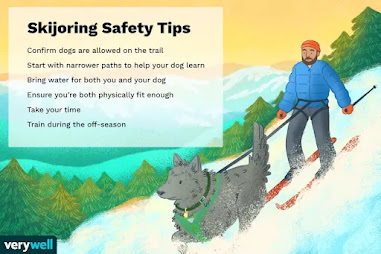How to Get Started with Skijoring Dog Instructions Equipment Safety Tips
Skijoring is a winter sport that is widely described as a combination of cross-country skiing and dogsledding. However, when skiing, your dog (or dogs) will not pull on the sled. Instead, they help to pull you together while you are cross country skis.
Skijoring has been around for many years but has not been widely used in the U.S. until recently. As its popularity grew, so did skiing, competition events, training, and support organizations.
Many skijoring facilities and events are located in Alaska, the Midwest, and the Northeast where winter sports are usually held.
The game offers a variety of benefits and can be an enjoyable experience if both you and your dog are well trained and well prepared.
What is Skijoring?
Modern skiing is believed to have originated in Scandinavia, although there are mixed reports about when, where, and how the sport was developed. (although similar) sports.
Skijoring can refer to any activity in which the operator is pulled by an animal or animals (horse, dog, deer, or elk), or a powerful motor vehicle (such as a car, snowmobile, or airplane). Two of the most common skijor activities today involve a horse or a dog.
The word "skijor" is of Norwegian origin and means "driving on snow." According to the skijor history provided by Skijor International, there have been reports of animals dragging people on skis for millenniums in the Altai Mountains of Central Asia.
Equine Skijoring
In the early 1900's, equine skijoring — a ski ride — became popular in parts of Europe, including Switzerland and France.
Eventually, the game reached the United States and Canada where it is still being played today. Skijor USA and Skijor Canada are both equine skijor organizations that support competitive events throughout North America, particularly in the mountainous regions (Colorado, Utah, Idaho, Wyoming, Montana).
During an equine skijor race, a horse can travel up to 25 miles [40 km] an hour or more while pulling a propeller and jumping over obstacles.
Dog Skijoring
Skiing with the help of a dog is called canine skijoring, dog skijoring, or dog skiing. There are reports suggesting that this variation in sport dates back to ancient China where athletes were likely drawn by ten or more dogs.
Today, skiing usually involves just one or two dogs. The keeper and the dog are connected by a green cord, called a towline, and the dog provides assistance while running and pulling but they do not do all the work.
Ice skis can be on an old cross country skis but are usually on skate skis (especially if they are taking part in a skijor race).
Classic skiing is a traditional variation of Nordic skiing and looks like an ice rink. This style is very easy for beginners to learn because it mimics the movements they already know.
Skate skiing is a new discipline that involves movements that look like ice skating. It requires more balance and technical skill than the old skiing and can be difficult for beginners to learn.
Today, the dog skijoring game is gaining popularity throughout the Midwest and East Coast where glaciers are popular. Skijor participants may enjoy jogging along the jungle trails or take part in any skijor race available throughout the winter.
Health Benefits
Cross country skiing is a great way to stay active in the winter, burn calories, and keep your muscles strong during the colder months.
During a 30-minute run, a person weighing 150 pounds [150 kg] may burn 286 calories during a moderate ice skating rink. It will increase muscle strength and endurance throughout the body.
But there are other major health benefits too. Another study of 2,087 men aged in Finland found that leisure time skiing across the country was negatively and independently associated with every cause of death (i.e., death from any cause) .2
And another study published in 2019 found that skiing may reduce the risk of serious cardiovascular events and cause death by reducing inflammation, improving heart rate, and reducing other risk factors for heart disease.3
But many who participate in skiing say that the benefits extend far beyond the physical realm. In fact, most participants say that the value of exercise with your dog is immeasurable. "The bond that grows between you and your dog is deep," said Kevin Murphy.
Murphy is a skijor expert who has been involved in the sport for 14 years. He is also a skijor race organizer, promoter, and founder of K9 Powered Sports, an app for those who participate or want to take part in this activity. He says when he started skiing it helped him to control seasonal affective disorder (SAD), a condition that can affect people living in areas where it is very cold and dark in winter.4
"Skijoring helps you look forward to winter," says Murphy. "It helps you avoid getting stuck in your house during the long winter months. Now when it snows, I feel like I'm 8 years old again."
And because you do not need to be a skilled janitor to participate, skiing is accessible to anyone who is eager to learn and a healthy dog.
How to Get Started with Skijoring
To ensure a safe and enjoyable experience, you and your dog must be well-equipped and well-prepared for the game. You should be comfortable in cross-country skis before attempting to ski.
There are other people, like Murphy, who learn skiing and skiing at the same time. However, he says most people have experience of skiing before they start.

0 Comments